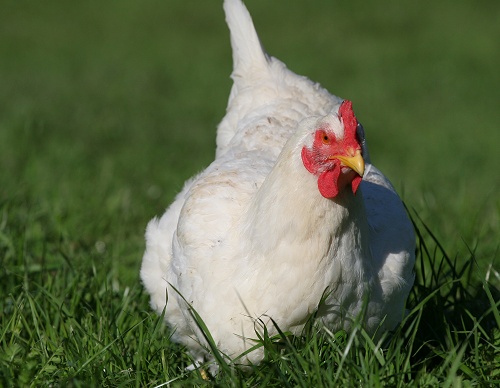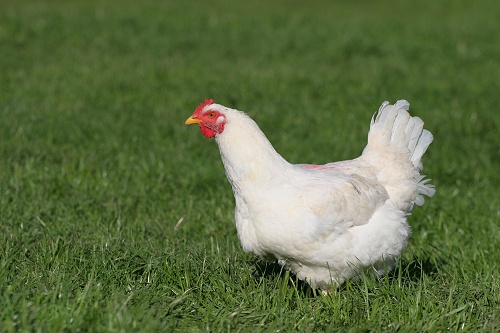 Nico, Fran and the “broiler” chicken crew are among the most social critters at the sanctuary. They run towards visitors, inquisitively cock their heads to the side, give you the “chicken eye”, and wait for any sign of melons. These birds always make an impression on visitors (mostly good but sometimes a little intimidating when they jump up and mistake a finger for a grape) because of their larger than life personalities and size.
Nico, Fran and the “broiler” chicken crew are among the most social critters at the sanctuary. They run towards visitors, inquisitively cock their heads to the side, give you the “chicken eye”, and wait for any sign of melons. These birds always make an impression on visitors (mostly good but sometimes a little intimidating when they jump up and mistake a finger for a grape) because of their larger than life personalities and size. These chickens came from two rescues. The first group arrived after Hurricane Katrina destroyed a Mississippi broiler facility (Animal Place helped pull 1,100 young birds) and the second when Oakland Animal Control confiscated dying birds being shipped (legally) through the mail at only a day of age. It may shock you, but these birds are killed at only 6-weeks-old, just babies! Nine billion of them are slaughtered every year…they aren’t protected by federal or many state laws, so they can be housed and killed in any way.
And when they are saved, these birds fight against generations of genetic selection for birds who could gain a rapid amount of weight in a short amount of time. They have a lot of health problems. We monitor their health with monthly checks and manage their weight with special feeding schedules. (The ladies call it dieting, and they aren’t too fond of it.) Breakfast and dinner consist of chicken feed mixed with low calorie rice hulls, and lunch is a healthy helping of lettuce, grapes, and melons. Despite our efforts, these chickens have a much higher incidence of foot infections, heart problems, and premature death than the smaller laying chickens. In fact, of the 100 birds who arrived from Hurricane Katrina, nearly half died from heart attacks and heat stroke within the first year.

Hannah, a Katrina rescue, has a foot infection called bumblefoot that is caused by her weight. Hannah likes pecking at the dirt looking for tasty treats and is one of the first to bound over to visitors, but the constant pressure from her favorite pastimes cause her feet to develop sores which become infected. Foot sores can take many months to heal, are terribly painful, and require treatment with oral antibiotics and twice weekly foot soaks, flushing, and wrapping. We wrap a disc from a styrofoam pipe insulator to the bottom of the infected foot to help keep the weight off the painful center of the foot. Another disc is attached to the good foot to keep the girls from being lopsided while wearing only one platform shoe. You should see the confused look on the faces of the hardware store clerks when I explain why I need pipe insulators in summer!
Last month we were closely monitoring Matt, the lone rooster from the Oakland rescue, because he had started wheezing and quit crowing. We were afraid his unnatural size was leading to an early death by heart failure, a very common and abrupt ending sanctuaries see with many young “meat” birds. We gave a dewormer in case lung parasites were making it more difficult for him to breathe, monitored his feeding closely, and started to weigh him weekly. After a week of treatment he wasn’t wheezing anymore, but was still breathing loudly. A few days later we heard him crow again for the first time. We hope that keeping his weight down will help Matt live to the ancient broiler chicken age of 4 years.
Although the broiler ladies and Matt have much shorter lifespans and can develop serious health problems due to their genetics, they don’t let it get them down. At the sanctuary, they live the good chicken life and remind us that grapes, grass, sunshine, are some of the best things in life.






1 comments:
Abby introduced me to Matt just last weekend. I fell in love with him instantly. He came to greet me and I spent some time with him and when I had to leave, I swear he gave me these big puppy dog eyes begging for me not to go. I believe a romance could be blossoming, move over Howie, a new stud is moving in on your girl :)
Roni
Post a Comment